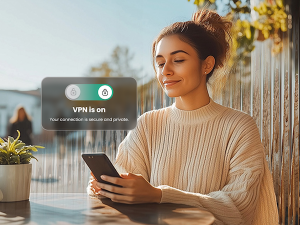New Year, New Digital You: Consumer Security Findings from McAfee’s Latest Report
2020 was a year unlike any other. We transitioned from the corporate office to the home office, participated in distance learning, and figured out how to communicate with one another from afar. We sought out new forms of entertainment by streaming countless movies and TV shows and found new ways to stay active with at-home workouts. But none of this would’ve been possible without our devices and the technology we rapidly adopted. In fact, data shows that we accelerated five years forward in digital adoption during the first two months of the pandemic alone. And according to findings from our 2021 Consumer Security Mindset Report , online alternatives will continue to replace activities in people’s lives and routines that were once in-person.
Online Alternatives Are Here to Stay
In the past year, many of us started to use or increased our use of various online tools. For example, online banking usage increased from 22% in 2020, online fitness classes increased by 7%, and virtual doctor’s appointments increased by 9%. We’ve adapted to the convenience of these online alternatives and have used them to replace activities that were once primarily in-person. Additionally, 77% of survey respondents indicated that they now use or have adopted common features designed for convenience, such as text and email notifications, web or mobile applications versus desktop sites, and more.
Online alternatives will continue to replace activities in people’s lives that were once in-person. According to our survey, the top digital activities that will remain part of our routines even as social distancing and stay-at-home restrictions lift include online banking, social engagements, and personal shopping. But as we continue to rely on technology to complete these tasks, how are we adapting our security habits to greater time spent online?
New Digital Worlds Also Means an Increase in New Digital Threats
The more time we spend online interacting with various apps and services, the greater our exposure is to potential cybersecurity risks and threats. So, as we continue to adapt to and embrace our new digital world, hackers are simultaneously taking notes. Survey results show that 71% of respondents are most concerned about their financial data being stolen or compromised, while 68% are concerned that their personal information could get hacked.
A heightened sense of security is of the utmost importance so we can continue to live our digital lives free from worry. But 29% of survey respondents don’t feel very confident about their ability to prevent a cyberattack and believe that they don’t have what they need to prevent one. And while another 40% is confident in their ability to prevent an attack, they think they could better understand how to identify or combat threats.
Even with these concerns, there still appears to be a discrepancy between our perceptions around online security versus our actions. While 70% of respondents stated that they purchased at least one connected device in 2020, only 50% bought security software, and only a quarter admitted that they check if their security software is up to date. But to preserve our digital wellness as we adopt new technology into our lives, we must upgrade our security habits in tandem. After all, it’s better to prevent a problem than be in a position of having to fix it.
Stay One Step Ahead of Hackers in 2021 and Beyond
To help prevent a hacker from striking, it helps to think about why they would want your data in the first place. However, over half of U.S. respondents admitted that they never considered how much their online data is worth. Hackers are always looking for ways to exploit others for money. By scavenging and stealing our personally identifiable information over the internet, hackers can piece together our identities – a valuable asset and can be sold for a lot of cash.
To stay one step ahead of hackers and protect your digital wellness into the new year and beyond, continue to work on your own online habits and follow these security tips:
Use multi-factor authentication
Two or multi-factor authentication provides an extra layer of security, as it requires multiple forms of verification like texting or emailing a secure code to verify your identity. Most popular online sites like Gmail, Dropbox, LinkedIn, Facebook, etc. offer multi-factor authentication, and it takes just a few minutes to set it up. This reduces the risk of successful impersonation by criminals who may have uncovered your information by keyboard snooping.
Connect with caution
Hackers tend to lurk in the shadows on public Wi-Fi networks to catch unsuspecting users looking for free internet access. If you have to conduct transactions on a public Wi-Fi network, use a virtual private network (VPN) like McAfee® Safe Connect to help keep you safe while you’re online.
Browse with added security
Use a comprehensive security solution, like McAfee Total Protection, which can help protect devices against malware, phishing attacks, and other threats. It includes McAfee WebAdvisor, which can help identify malicious websites.
Enable security settings
When using third-party tools like video conferencing platforms, adjust your security settings by password protecting your meetings and blocking other meeting attendees from sharing their screens. You can also adjust your device’s app permissions to only access your location when actively in use, or enable safe browsing options to protect you from malicious websites.











